Every transgender patient requires individualized care. We understand that there is no “one story” for transitioning. Therefore we offer a range of procedures as bottom surgery options .
Patients can choose with us, which procedure is best for them according to their goals, as well as their general health and social situation. For example some trans-feminine patients may choose to have everything done except the creation of a vagina (zero depth procedure) as it’s a gentler option with a faster recovery. Other patients are not at a point in their lives where they can commit to the dilation schedule that goes along with vaginoplasty so may choose orchiectomy alone.
We offer the following procedures which are listed from the most simple to the most complicated.
Orchiectomy
What is it?
This means removal of both testicles. This is done via a small two inch incision in the middle of the scrotum. It is a twenty minute procedure and patients go home that day.
Is this the procedure for me?
For some patients this may be the only procedure they choose to do and will never have any further bottom surgeries. Other patients choose to do this for financial reasons, others have not had hair removal or are not ready to look after a new vagina (dilation, douching ). Another group of patients may choose to do this because they are experiencing difficulties in regulating their hormone levels, or some of their medications are not agreeing with them ( typically testerone blockers e.g. spironolactone)
Having the testicles removed does not interfere with your ability to have bottom surgery in the future.
Whats the recovery like?
Patients usually leave hospital once recovered from anaesthesia. There is very little pain – some patients will have groin discomfort. Most go back to work the next day.
Orchiectomy with Scrotoplasty
What is it?
Some patients will opt to have the extra scrotal skin removed at the time of testicle removal. Some patients prefer this “tidier” appearance. It results in a longer incision (about five inches) down the middle of where the scrotum was, to get rid of the extra tissue.
Is this the procedure for me?
This is only for you if you have no plans to have a vagina made in the future. The reason is it gets rid of some of the skin which would be used to line the vagina.
Whats the recovery like?
Patients usually leave hospital once recovered from anaesthesia. Like the orchiectomy there is very little pain – some patients will have groin discomfort. Most go back to work the next day.
Zero-depth or Dimple Vaginoplasty
What is it?
A growing number of patients will request this procedure. It means feminizing the genitalia- ie removing the penis, creating a clitoris, removing the testicles and scrotum and making labiea. However unlike the full vaginoplasty we do not make a vaginal canal, but instead just create the appearance of one, which is known as a “dimple”. Ultimately everything looks the same on the outside, but there is no vaginal canal capable of intercourse with a penis.
Is this the procedure for me?
Many patients may never have interest in penetrative intercourse. By not creating a vaginal canal patients don’t have to dilate and cut down on both the recovery time and the risks of surgery itself. Older patients or patients with medical problems may opt for this as it’s a shorter and less dangerous surgery. It is of course very important to be sure that this is the procedure for you. It may be possible to create a vagina in the future if the patient should so desire, but this would be much more difficult.
Whats the recovery like?
Patients require a stay in hospital one to three nights usually. Depending on the patients job, typically two to four weeks off work is needed.
Penile Inversion Vaginoplasty
What is it?
This is the most requested bottom surgery by transgender women. It involves changing the male genitalia to look, feel, and function like female genitialia. We use a “penile inversion” technique. In this surgery the testicles are removed, followed by the scrotal skin. This is put to one side and prepared to make the deepest part of the vagina. The skin of the penis is then removed. Following this the head of the penis is used to make the clitoris which can allow the patient to orgasm. The erectile tissue is removed, the urethra is shortened and the vaginal canal is made. This is usually lined with both the penis skin and the scrotal skin.
Is this the procedure for me?
Taking care of a new vagina is a big commitment and requires the patient being prepared to look after it (dilation) for the rest of their lives.It is important to be at a place in your life where you can cope if complications happen, and with taking care of a new vagina.
Whats the recovery like?
The patient usually stays in the hospital recovering for about three days. Typically four to six weeks off work is necessary.
Peritoneal Pull Through Vaginoplasty
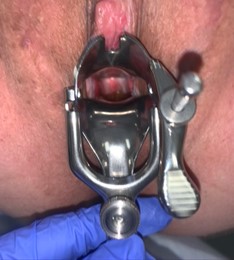 This procedure is a new approach in the gender affirmation surgery world but has been used in the gynecology world for years. About 1/5000 non-transgender women are born with “vaginal agenesis” meaning the vagina never forms and the peritoneum has been used to line the new vagina in these patients.
This procedure is a new approach in the gender affirmation surgery world but has been used in the gynecology world for years. About 1/5000 non-transgender women are born with “vaginal agenesis” meaning the vagina never forms and the peritoneum has been used to line the new vagina in these patients.
What, however, is the peritoneum? Inside the abdomen there is a membranous layer of tissue which lines the abdominal cavity. It is flimsy but a few different ways have been described to use it to line the new vagina.
Some surgeons have taken a piece out and used it as a graft- as in there is no blood supply and it must “take” like a graft. Others have used it to “cap” the penile inversion technique while still using penile and scrotal skin to line the lower parts of the vagina. In my practice we have tried to line as much of the new vagina as possible with the peritoneum that we get to with a robot.
The hope would be that unlike the penile inversion technique, where skin lines the new vagina, this membrane would line it instead and perhaps act more like a “natural” vagina.
The downside to this technique is the patient needs cuts on the belly where the surgeon goes in to harvest the peritoneum. This opens up other potential risks as there are organs now close by to where we are working that could be damaged such as the intestines and ureters.
In my practice we have been able to almost completely line the new vagina with peritoneum. The first inch or so is still lined by the penile inversion skin. Therefore, there is no change in the outside appearance of the vagina.
Depending on how much of the peritoneum can be harvested (this depends on the patient’s anatomy) more depth may be achieved.
However, for patients who have been on blockers from an early age and do not have enough tissue to line a vagina this procedure may indeed be a better option.
Dr. Gallagher performs this procedure along with a urologist. Wait tomes for this procedure are generally a year or more to line up the doctor’s schedules.
Custom Clitoris
There are a range of different ways to create the clitoris from the glans of the penis. Dr Gallagher typically uses a modification of the Chonburi flap which is shown to give good appearance and sensation. Some patients may however notice certain areas of the tip of the penis to be more sensitive than others – such as the frenulum. Dr. Gallagher can usually work with individual patients in order to incorporate these sensitive areas into the new clitoris design.
Male to female Labiaplasty
What is it?
Every attempt is made at the orginal bottom surgery to give a pleasing natural appearance. However some things may need to be addressed at a later surgery. Labiaplasty is a term used to describe whatever modification a patient may need to improve the appearance. The most common procedure is to make the labia majora meet in the midline at the front. This can’t be done at the first surgery due to the blood supply to the vagina.
Is this the procedure for me?
Patients are encouraged to wait nine to twelve months after bottom surgery before undergoing labiaplasty. This allows everything to heal and is the safest route. Not all patients want or need this surgery, but it can be used to enhance the appearance, and get rid of annoying scars or lumps.
What is recovery like?
Recovery from this surgery really depends on what needs to be done. In some cases the patient may not even have to go to sleep. Usually it is an outpatient procedure with a few days off work.
Bottom Surgery Revision Surgeries
What is it?
We welcome patients who have had their surgery originally done elsewhere. We can often help with complications or an unpleasing appearance.
Is this the procedure for me?
- Typical problems patients will seek help for include:
- Loss or lack of vaginal depth,
- Scar tissue,
- Lumps and bumps,
- Too large a clitoris
What is recovery like?
Recovery from this surgery really depends on what needs to be done. In some cases the patient may not even have to go to sleep. Usually it is an outpatient procedure with a few days off work.
Gender Affirming Add on procedures.
Many patients may add on other gender affirming and rejuvenating procedures on at the time of surgery. Some common procedures that can be added.
- Torso masculinization
- Liposuction
- Abdominoplasty
- Breast Augmentation/ Top Surgery
- Brachioplasty
- Thigh lift
- Morpheus Body
- Labiaplasty
- Botox (Jaw line reduction, Brow lift)
- Fillers (Lips and Cheeks)
- Neck liposuction
- Lip Lift
MTF Top Surgery
Dr Gallagher will work to provide the most affirming result for each individual patient.
There are often subtleties involved in breast augmentation for transfeminine patients which require attention and adaption of the technique in order to get the best results possible.
Growth already there
First, we take into consideration what changes hormones have already caused. The typical advice is to wait 2 years at least so we have had maximal benefit on the hormones and the breasts have stopped changing shape (we never want to operate on a moving target).
We take into consideration the size and shape of the breasts.
Tuberous breasts
Often many transgender women may notice that they have tuberous type breasts which means the fold it high and the lower part of the breast is missing the rounded contour.
Also, it’s very common to have asymmetrical breast.
We will take all these factors into consideration when choosing size and position of the implants. Indeed, we will often choose 2 different sized implants in order to balance out the size differences.
Size preference is very personal, and Dr Gallagher will discuss the pros and cons in detail. Often there is a “sweet spot” range a chest can accommodate. If we go beyond this, we may cause distortions which can lead to un-natural results or results that are prone to drooping with time. Therefore, Dr. Gallagher and the patient will typically agree on a range before the surgery.
Transgender Woman Breast Surgery Options
- Many transgender women may benefit from having the implant placed on top of the muscle. This is to prevent the implants from being pushed out top the sides and also to allow the rounded contour of the lower part of the implant to shape the lower part of the chest.
- Often the nipples on a transwoman’s chest are spaced a little further apart. While we want to create cleavage, this can be a little more challenging as it is critical to center the implant on the nipple. Typically, as swelling reduces however, and the implants settle it is possible to get nice cleavage in a bra.
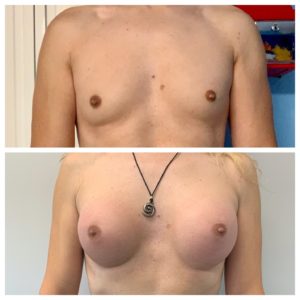
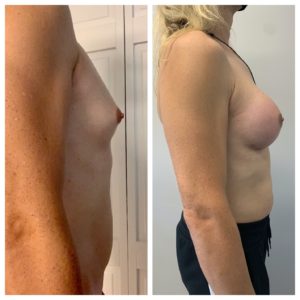
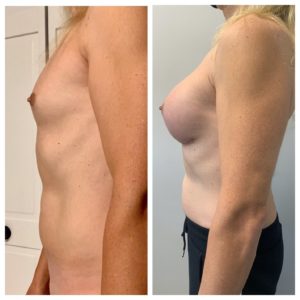
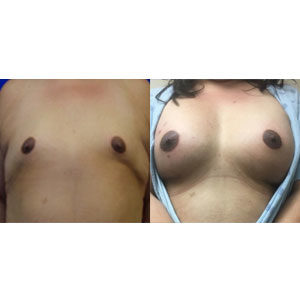
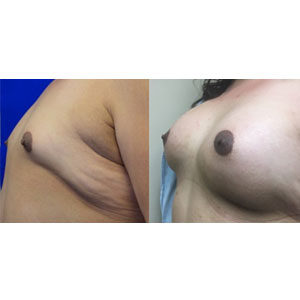
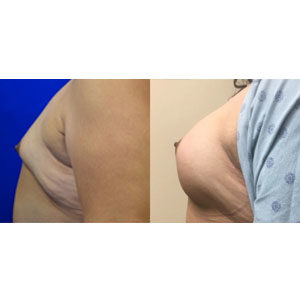
Most trans-feminine patients will get breast growth after having been on hormones. We encourage patients if they can, to wait for the full effects of hormones to take effect, before deciding if they want or need surgery to feminize the breasts. This often takes two years.
Mastoplasty involves two basic approaches to feminize the breasts.
Breast Augmentation
Many patients just require a larger volume cup size. This can be done either using the patient’s own fat taken from other parts of the body where it is not wanted, usually the abdomen, this is known as fat grafting . It can also be done by using an implant. There are a number of options and approaches to this. Dr. Gallagher will help you understand which option will be best to enhance and feminize the breast.
The main decisions you will make with Dr. Gallagher are
- Type of implant Silicone vs Saline
- Placement of incision
- Whether to place the incision above or below the muscle
- What size implant to use
Most patients opt for a silicone implant being placed through an incision in the fold underneath the breast and underneath the muscle.
Mastopexy or shaping
Sometimes the breast may need additional shaping or lifting to help feminize the appearance. For example in many transgender women the fold underneath the breast may sit high. This can be adjusted. Patients usually have this procedure at the same time as an augmentation.
Nipple Enlargement
Hormones can increase breast tissue but a lot of transgender patients may notice disappointing feminization of the nipples themselves. Various surgical techniques can be used to increase projection of the nipples.
Body Feminization/ Contouring
Dr. Gallagher uses a range of techniques to help give a more feminine curvier appearance to the patient’s chest, abdomen, buttocks or hips.
Depending on the patient’s problem areas and preferences a combination of liposuction, fat grafting and lifts can be used as an individualized approach to help give a more affirming appearance.
Recovery
In addition to the incisions down below the patient will typically have 3 small incisions on the abdomen also. Most patients have only a small amount of extra pain from these. On average patients leave the hospital about 3 days after surgery. Most patients travelling in stay in the area for about 9 days. Recovery otherwise looks a lot like penile inversion vaginoplasty with typically 6 weeks taken off work.
Dilation is just as important after surgery with this technique.


